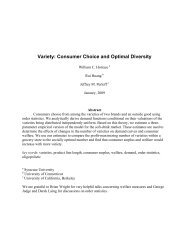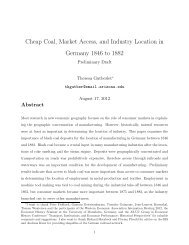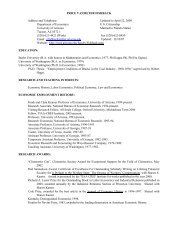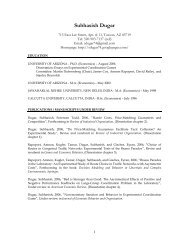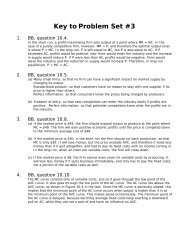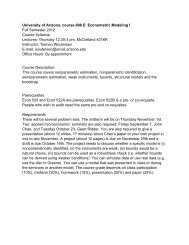The comparison <strong>of</strong> static <strong>and</strong> dynamic results suggests that incorrectly estimating a static model can lead to estimates with very large biases. In our application a static model substantially overestimated willingness to pay to live with other white neighbors. However, the bias <strong>for</strong> ozone <strong>and</strong> crime, while also large, runs in the opposite direction (in absolute terms). 7 Conclusion We develop a tractable model <strong>of</strong> neighborhood choice in a dynamic setting along with a compu- tationally straight<strong>for</strong>ward estimation approach. We estimate the model using a novel data set that links buyer <strong>and</strong> seller demographics to detailed house characteristics. We use the dynamic model to recover estimates <strong>of</strong> moving costs <strong>and</strong> the marginal willingness to pay <strong>for</strong> neighborhood attributes <strong>and</strong> compare these results with an alternative static estimator to explain the biases associated with static approaches. The model <strong>and</strong> estimation approach are applicable to the study <strong>of</strong> a wide set <strong>of</strong> dynamic phenomena in housing markets <strong>and</strong> cities. These include, <strong>for</strong> example, the analysis <strong>of</strong> the microdynamics <strong>of</strong> residential segregation <strong>and</strong> gentrification within metropolitan areas. 30
References Abraham, J., <strong>and</strong> P. Hendershott (1996): “Bubbles in Metropolitan Housing Markets,” Journal <strong>of</strong> Housing Research, 7(2), 191–207. Bajari, P., C. L. Benkard, <strong>and</strong> J. Krainer (2005): “House Prices <strong>and</strong> Consumer Welfare,” Journal <strong>of</strong> Urban Economics, 58, 474–487. Bajari, P., <strong>and</strong> M. Kahn (2005): “Estimating Housing <strong>Dem<strong>and</strong></strong> With An Application to Explaining Racial Segregation in Cities,” Journal <strong>of</strong> Business <strong>and</strong> Economic Statistics, 23(1), 20–33. Bayer, P., F. Ferreira, <strong>and</strong> R. McMillan (2007): “A Unified Framework <strong>for</strong> Measuring Preferences <strong>for</strong> Schools <strong>and</strong> <strong>Neighborhoods</strong>,” mimeo, Duke University. Bayer, P., <strong>and</strong> R. McMillan (2006): “Racial Sorting <strong>and</strong> Neighborhood Quality,” NBER Working Paper No. 11813. Bayer, P., R. McMillan, <strong>and</strong> K. Rueben (2004): “An Equilibrium <strong>Model</strong> <strong>of</strong> Sorting in an Urban Housing Market,” NBER Working Paper No. 10865. Bayer, P., <strong>and</strong> C. Timmins (2005): “On the Equilibrium Properties <strong>of</strong> Locational Sorting <strong>Model</strong>s,” Journal <strong>of</strong> Urban Economics, 57, 462–477. (2007): “Estimating Equilibrium <strong>Model</strong>s <strong>of</strong> Sorting Across Locations,” Economic Journal, Forthcoming. Berry, S. (1994): “Estimating Discrete Choice <strong>Model</strong>s <strong>of</strong> Product Differation,” R<strong>and</strong> Journal <strong>of</strong> Economics, 25, 242–262. Berry, S., J. Levinsohn, <strong>and</strong> A. Pakes (1995): “Automobile Prices in Market Equilibrium,” Econometrica, 63, 841–890. Bishop, K. (2007): “A <strong>Dynamic</strong> <strong>Model</strong> <strong>of</strong> Location Choice <strong>and</strong> Hedonic Valuation,” working paper, Washington University in St. Louis. Capozza, D., P. Hendershott, C. Mack, <strong>and</strong> C. Mayer (2002): “Determinants <strong>of</strong> Real House Price <strong>Dynamic</strong>s,” NBER Working Paper No. 9262. Card, D., A. Mas, <strong>and</strong> J. Rothstein (2006): “Tipping <strong>and</strong> the <strong>Dynamic</strong>s <strong>of</strong> Segregation in <strong>Neighborhoods</strong> <strong>and</strong> Schools,” mimeo. Carranza, J. E. (2007): “Estimation <strong>of</strong> dem<strong>and</strong> <strong>for</strong> dierentiated durable goods,” mimeo. Case, K., <strong>and</strong> C. Mayer (1995): “Housing Price <strong>Dynamic</strong>s within a Metropolitan Area,” NBER Working Paper No. 5182. 31



